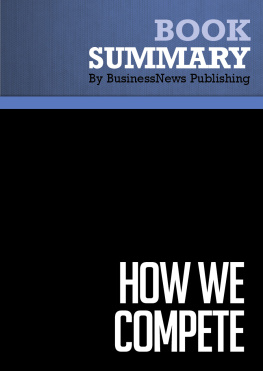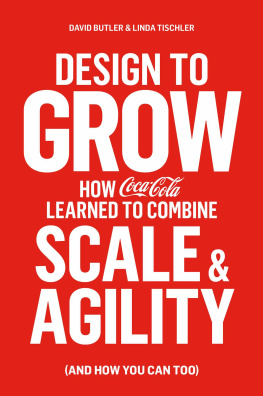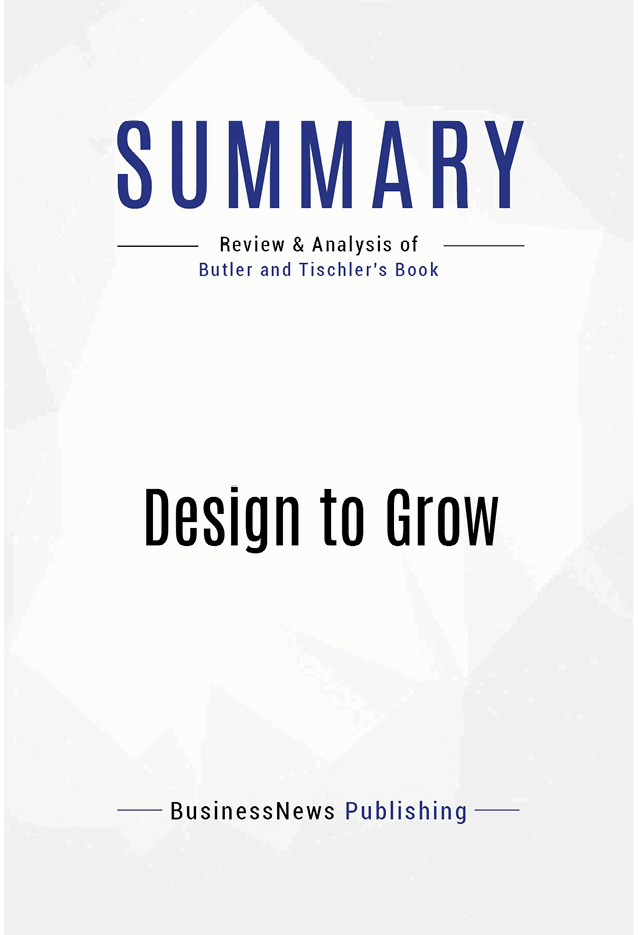Book Presentation: Design to Grow by David Butler and Linda Tischler
Book Abstract
MAIN IDEA
Scale and agility are essential for a company to succeed. Large and established corporations have scale (in terms of financial resources, brands, assets and people) but often struggle to be able to adapt quickly to the marketplace. Startups are by definition nimble but often struggle to scale. The fact is tomorrow's business winners will combine scale with agility.
So is it possible to achieve that? For more than a century, Coca-Cola has successfully scaled its flagship $170 billion brand to more than 200 countries but in the last decade, it has also mastered being agile as well. It has achieved this by using "Design" exceptionally well. Design is about intentionally connecting things to solve problems.
Strategic design always focuses on the same three questions:
- Why : Purpose
- How : Process
- What : Product
If you want both scale and agility, get better at using and applying the principles of design.
"For over a century, Coca-Cola used design to scale to over two hundred countries, build seventeen billion-dollar brands, partner with more than twenty million retail customers, and sell close to two billion products a day. But the company is still learning. Over the last decade, it has focused on mastering how also to use design to create agility something most established companies, including Coca-Cola, struggle with. Design has helped one of the largest companies on the planet become nimbler and more adaptable to a complex and changing world. The future belongs to companies that design on purpose."
David Butler and Linda Tischler
About the Author
DAVID BUTLER is Coca-Cola's Vice President of Innovation and Entrepreneurship. He is responsible for the company's brand building, strategic planning and innovation projects. Prior to joining Coca-Cola, Mr. Butler founded a process consulting firm, consulted with Gucci, United and Caterpillar and designed large-scale systems for UPS, Delta and CNN. He is a graduate of the University of South Florida and St. Petersburg College.
LINDA TISCHLER is an editor at Fast Company magazine. She writes articles about ideas which lie at the intersection of design and business. She was previously an editor at Boston Magazine and a writer on art and design for Metropolitan Home, the Boston Globe, the International Herald Tribune and others. She is a graduate of Boston University.
Important Note About This Ebook
This is a summary and not a critique or a review of the book. It does not offer judgment or opinion on the content of the book. This summary may not be organized chapter-wise but is an overview of the main ideas, view points and arguments from the book as a whole. This means that the organization of this summary is not a representation of the book.
Summary of Design to Grow (David Butler and Linda Tischler)
1. How to design for scale
To scale successfully, you have to use design to simplify, standardize and then integrate your different functions together efficiently. In other words, you try and build a Lamborghini an optimized supply chain you can replicate to the hilt. That's what it takes to make millions of sales.
At one time, design was considered to be an art form and designers were an integral part of the creative team of any enterprise. Today, that definition doesn't really hold true. Design is being used all the time to create real business value.
Pure and simple, design is about how you intentionally connect things to solve problems. Design is "good" if it solves a problem, makes a difficult task less complicated, makes it easier to use a product, etc. The value of design arises from how efficiently the product helps users solve their problems and less about whether you win any awards.
"Good design makes things less complicated. Bad design makes things more complicated. Bad design is the default mode, since it takes the least effort to create. Good design, by contrast, never happens by chance you have to be very intentional."
David Butler and Linda Tischler
To generate good designs, it's helpful to think in terms of systems which combine visible and invisible elements. At its heart, a system is a structure for generating behaviors. People use systems to try and solve their problems. Designers connect systems together to create solutions which add value.
"Anyone can learn how to connect things in a way that makes them less complicated, simpler, and easier to do. Connecting can apply both to very tangible things like machines to abstract things like supply chains, organization charts, and customer relationship."
David Butler and Linda Tischler
To illustrate what design is all about, take the example of Minaqua, Coca-Cola's bottled water business in Japan. Selling water is a tough business because it's hard to differentiate your product in any meaningful way and therefore the margins tend to be razor thin. You have to design everything very carefully to make money.
Minaqua had been a very solid performer for Coca-Cola in Japan but by 2010 the brand was showing signs of fatigue. Minaqua's market share was at an all-time low and to right the ship, Coca-Cola Japan brought together a crossfunctional team to revamp Minaqua's operations.
"They uncovered a key insight: In Japan, recycling is not a nice-to-have; it's a way of life. Japan recycles more than 70 percent of its plastics and more than 80 percent of aluminum cans. When the team stepped back and looked at Minaqua, it was clear the product wasn't connecting to any of this insight."
David Butler and Linda Tischler
The team also noted that Tokyo is a very expensive place to live and therefore apartments are small. That means a bin of empty water bottles takes up a lot of room. This isn't an issue elsewhere but in Japan, every square inch is precious to the apartment dweller.
Based on these insight, Coca-Cola Japan relaunched Minaqua. It re-branded it as ILOHAS (Lifestyles of Health and Sustainability) and packaged the water in a new Flex bottle which weighed just 12 grams when empty 40 percent less than other plastic bottles. The fun part, however, was that empty Flex bottles made a delicious crunching sound when twisted by hand into a thin, gnarly scrap of plastic. That meant empty Flex bottles took significantly less room in recycling bins and ultimately in waste disposal.
Coca-Cola Japan then designed an advertising program which suggested ILOHAS bottled water was "water which changes the world with your small action." They introduced a new ritual: 1. Choose, 2. Drink, 3. Twist and 4. Recycle. This simple message went viral and before long consumers were posting videos on YouTube of themselves crushing the bottles and making interesting things with the cast-offs. Coca-Cola also pointed out lighter bottles meant less carbon dioxide in the manufacturing process, lighter delivery loads for its trucks, less waste for recycling, etc.






